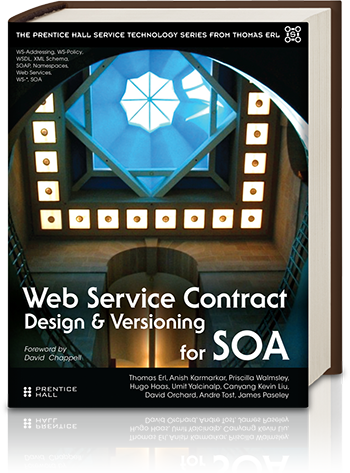About this Book
For Web services to succeed as part of SOA, they require balanced, effective technical contracts that enable services to be evolved and repeatedly reused for years to come. Now, a team of industry experts presents the first end-to-end guide to designing and governing Web service contracts.
Writing for developers, architects, governance specialists, and other IT professionals, the authors cover the following areas:
Understanding Web Service Contract Technologies
Initial chapters and on-going supplementary content help even the most inexperienced professional get up to speed on how all of the different technologies and design considerations relate to the creation of Web service contracts. For example, a visual anatomy of a Web Service contract documented from logical and physical perspectives is provided, along with a chapter dedicated to describing namespaces in plain English. The book is further equipped with numerous case study examples and many illustrations.
Fundamental and Advanced WSDL
Tutorial coverage of WSDL 1.1 and 2.0 and detailed descriptions of their differences is followed by numerous advanced WSDL topics and design techniques, including extreme loose coupling, modularization options, use of extensibility elements, asynchrony, message dispatch, service instance identification, non-SOAP HTTP binding, and WS-BPEL extensions. Also explained is how WSDL definitions are shaped by key SOA design patterns.
Fundamental and Advanced XML Schema
XML Schema basics are covered within the context of Web services and SOA, after which advanced XML Schema chapters delve into a variety of specialized message design considerations and techniques, including the use of wildcards, reusability of schemas and schema fragments, type inheritance and composition, CRUD-style message design, and combining industry and custom schemas.
Fundamental and Advanced WS-Policy
Topics, such as Policy Expression Structure, Composite Policies, Operator Composition Rules, and Policy Attachment establish a foundation upon which more advanced topics, such as policy reusability and centralization, nested, parameterized, and ignorable assertions are covered, along with an exploration of creating concurrent policy-enabled contracts and designing custom policy assertions and vocabularies.
Fundamental Message Design with SOAP
A broad range of message design-related topics are covered, including SOAP message structures, SOAP nodes and roles, SOAP faults, designing custom SOAP headers and working with industry-standard SOAP headers.
Advanced Message Design with WS-Addressing
The art of message design is taken to a new level with in-depth descriptions of WS-Addressing endpoint references (EPRs) and MAP headers and an exploration of how they are applied via SOA design patterns. Also covered are WSDL binding considerations, related MEP rules, WS-Addressing policy assertions, and detailed coverage of how WS-Addressing relates to SOAP Action values.
Versioning Techniques and Strategies
Fundamental versioning theory starts off a series of chapters that dive into a variety of versioning techniques based on proven SOA design patterns including backwards and forwards compatibility, version identification strategies, service termination, policy versioning, validation by projection, concurrency control, partial understanding, and versioning with and without wildcards.
Web Service Contracts and SOA
The constant focus of this book is on the design and versioning of Web service contracts in support of SOA and service-orientation. Relevant SOA design principles and design patterns are periodically discussed to demonstrate how specific Web service technologies can be applied and further optimized. Furthermore, several of the advanced chapters provide expert techniques for designing Web service contracts while taking SOA governance considerations into account.
Table of Contents:
Chapter 1: Introduction
Chapter 2: Case Study Background
Part I: Fundamental Service Contract Design
Chapter 3: SOA Fundamentals and Web Service Contracts
Chapter 4: Anatomy of a Web Service Contract
Chapter 5: A Plain English Guide to Namespaces
Chapter 6: Fundamental XML Schema: Types and Message Structure Basics
Chapter 7: Fundamental WSDL Part I: Abstract Description Design
Chapter 8: Fundamental WSDL Part II: Concrete Description Design
Chapter 9: Fundamental WSDL 2.0: New Features, and Design Options
Chapter 10: Fundamental WS-Policy: Expression, Assertion, and Attachment
Chapter 11: Fundamental Message Design: SOAP Envelope Structure and Header Block Processing
Part II: Advanced Service Contract Design
Chapter 12: Advanced XML Schema Part I: Message Flexibility, and Type Inheritance and Composition
Chapter 13: Advanced XML Schema Part II: Reusability, Derived Types, and Relational Design
Chapter 14: Advanced WSDL Part I: Modularization, Extensibility, MEPs, and Asynchrony
Chapter 15: Advanced WSDL Part II: Message Dispatch, Service Instance Identification, and Non-SOAP HTTP Binding
Chapter 16: Advanced WS-Policy Part I: Policy Centralization and Nested, Parameterized, and Ignorable Assertions
Chapter 17: Advanced WS-Policy Part II: Custom Policy Assertion Design, Runtime Representation, and Compatibility
Chapter 18: Advanced Message Design Part I: WS-Addressing EPRs and MAP Headers
Chapter 19: Advanced Message Design Part II: WS-Addressing Messaging Rules and Design Techniques
Part III: Service Contract Versioning
Chapter 20: Versioning Fundamentals
Chapter 21: Versioning WSDL Definitions
Chapter 22: Versioning Message Schemas
Chapter 23: Advanced Versioning
Part IV: Appendices
Appendix A: Case Study Conclusion
Appendix B: How Technology Standards Are Developed
Appendix C: Alphabetical Pseudo Schema Reference
Appendix D: Namespaces and Prefixes Used in this Book
Appendix E: SOA Design Patterns Related to this Book


